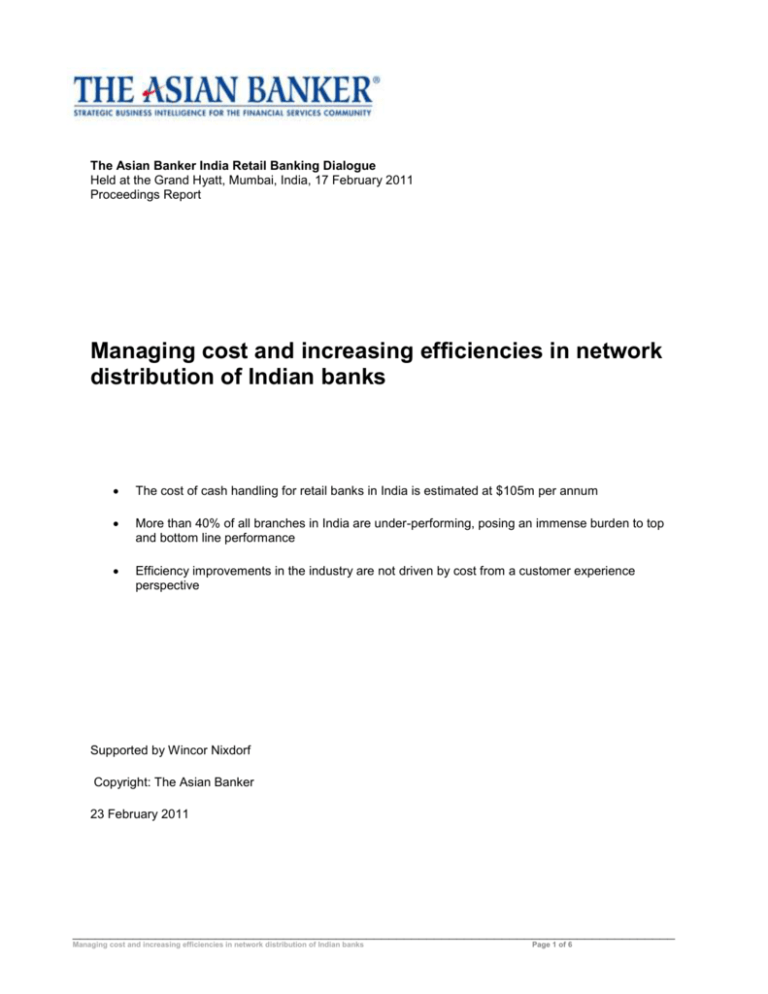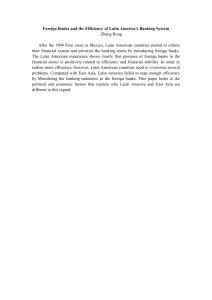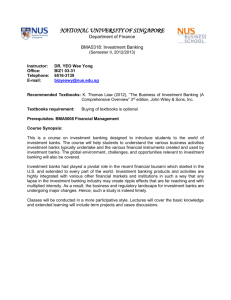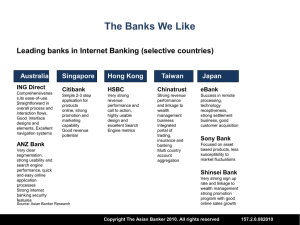The Asian Banker India Retail Banking Dialogue Held at the Grand
advertisement

The Asian Banker India Retail Banking Dialogue Held at the Grand Hyatt, Mumbai, India, 17 February 2011 Proceedings Report Managing cost and increasing efficiencies in network distribution of Indian banks The cost of cash handling for retail banks in India is estimated at $105m per annum More than 40% of all branches in India are under-performing, posing an immense burden to top and bottom line performance Efficiency improvements in the industry are not driven by cost from a customer experience perspective Supported by Wincor Nixdorf Copyright: The Asian Banker 23 February 2011 ________________________________________________________________________________ Managing cost and increasing efficiencies in network distribution of Indian banks Page 1 of 6 Held on 17th February 2011 at the Grand Hyatt, Mumbai, India, The following are the proceedings of “The Asian Banker India Retail Banking Dialogue” which was held to determine issues specific to the present state of the retail banking industry in India in 2010/2011. I. Introduction The Asian Banker “Innovation in Retail Banking Forum” was designed to augment Asian Banker Research’s own benchmarking insights with the experience of leading retail practitioners in the countries we serve. The heads of retail, strategy, IT and channel distribution of domestic and foreign financial institutions met at this forum to discuss, among other issues, the following: 1. Executing branch banking transformation 2. Managing cost in a bank’s distribution network 3. Driving efficiencies in the cash management cycle for Indian banks After taking a dip in 2008 and 2009, the Indian retail financial services industry has recovered to precrisis levels in terms of revenue and assets growth, though many banks have exited or scaled down their unsecured lending business in a shift to collateralised lending. The unsecured lending industry is still in a consolidation phase and in some areas has further contracted. Outstanding balances on credit cards last year shrank from $6.15 million in 2009 to $3.97 million in 2010. Hence, balancing risk return while maintaining pace of growth and productivity is crucial in the current environment. Looking forward, while the Indian regulator is further opening up the retail financial services industry for foreign banks, the biggest regulatory change will be the potential deregulation of savings rates which would significantly impact a bank’s business model in terms of transaction charges and service models. While Indian banks have focused much in the last years on back office and operations, solving front end issues is the next stage of evolution in channel management. Automated reprocessing of cash, which comprises more than 65% of the transaction structure in branches, is where the game is going to change. II. In attendance The session was attended by these senior executives: 1. 2. 3. 4. 5. 6. 7. 8. 9. 10. 11. 12. Chaired by: Mr Emmanuel Daniel, President and CEO, The Asian Banker Mr. Christian Kapfer, Associate Director (Research), The Asian Banker Mr. Shishir Verma, Head of Service Support, Retail Operations, Kotak Mahindra Bank Ltd Mr. Shailesh Rajyadhyaksha, Head Internal Controls, Retail Operations, Kotak Mahindra Bank Ltd Ms. Shobana Santhanam, Projects Head, Retail Operations, Kotak Mahindra Bank Ltd Mr. Rajnish Khare, Head of Remote Banking, Distribution Channels, Standard Chartered Bank Mr. Navin Puri, Country Head, Branch Banking, HDFC Bank Mr. Rakesh Kumar, Assistant Manager, Retail Liabilities Group, ICICI Bank Mr. Aalok Gupta, Country Head, Risk Management, Retail Banking, YES Bank Mr. Durgesh Pandit, Chief Manager, Retail Liability Group, ICICI Bank Mr. Mahendra Shinde, Manager, Retail Liability Group, ICICI Bank Ms. Maya Shanbhag, Chief Manager, RLG - Strategic Initiatives Team, ICICI Bank ________________________________________________________________________________ Managing cost and increasing efficiencies in network distribution of Indian banks Page 2 of 6 13. 14. 15. 16. 17. 18. 19. 20. 21. 22. 23. 24. 25. 26. 27. 28. 29. 30. 31. 32. 33. 34. 35. III. Mr. Prashant Jain, RLG - Strategic Initiatives Team, ICICI Bank Mr. Anil Kulkarni, Chief Manager - Projects, Automation & Systems, ICICI Bank Mr. Vere J. Carneiro, Managing Director & CEO, CITIZENCREDIT Co-operative Bank Ltd Mr. Abhilash Padmanabhan, Manager, Quality Assurance, YES Bank Mr. Praveen Suvarna, VP & Country Head - Quality Assurance, YES Bank Mr. Rahul Johri, Head of Consumer Banking, DBS Bank Ms. Sumita Advani, Regional Manager, Consumer Banking, DBS Bank Mr. Subrat Pani, Head, Cards, Kotak Mahindra Bank Ltd Mr. Surinder Chawla, EVP, Retail Liabilities Product Group, HDFC Bank Mr. Sanjeev Patel, EVP & Head, Direct Banking Channels, HDFC Bank Mr. Arvind Kapil, EVP & Head, Direct Sales Retail Liabilities, HDFC Bank Mr. Yusuf H Roopawalla, Head of Technology – India and South Asia, Information Technology, Standard Chartered Bank Mr. V. Murali, Chief General Manager, PBU, State Bank of India Mr. Antony D' Souza, Deputy General Manager, LIMA, Retail Banking, State Bank of India Mr. H. Subramanium, Deputy General Manager, Operations, Retail Banking, State Bank of India Mr. Mridul Sharma, SVP, Solution Delivery & CTO, IndusInd Bank Ms. Samika Biswasroy, Head of Strategy, DBS Bank Mr. P. Ponnuraj, Vice President, Business Intelligence Unit, Kotak Mahindra Bank Ltd Mr. Amitabh Panda, Vice President, Consumer Assets & CC Cross Cell, Kotak Mahindra Bank Ltd Mr. Hemant Baid, Vice President & Head - Personal Banking Products, Kotak Mahindra Bank Ltd Mr. Rahul Bhagat. Country Head, Retail Liabilities, Marketing & Direct Banking Channels, HDFC Bank Mr. KVS Manian, Group Head Consumer Banking, Kotak Mahindra Bank Ltd Mr. Ricardos Khoury, Regional Vice President, Head – Banking Division APAC Key discussion points The following topics were raised by the attendees: 1. 2. 3. 4. Successfully executing branch banking transformations Driving the customer experience Expanding channels to increase competitive position Making the cash management cycle more cost effective 1. Successfully executing branch banking transformations Only a few institutions are able to simultaneously invest in all domains, so competitive and Indian market realities dictate that some activities are valued over others. Indian banks over-focus on economics and process/technology, while aspects such as sales/merchandising, customer care and insights need improvement. Need for branch transformation strategy to be differentiated from aesthetic re-design and focus on customer segmentation. Striking a balance between on shop format and differentiated branch types is important to cater to a fragmented customer base. ________________________________________________________________________________ Managing cost and increasing efficiencies in network distribution of Indian banks Page 3 of 6 More than 40% of all branches in India are under-performing, posing an immense burden to top and bottom line performance. The integrated branch has five distinctive zones which are spatially and functionally integrated. Best practice looks at how a bank can navigate customers seamlessly through the various branch points. The trend of branch managers being in charge of all services—moving from business line to market management—has been adopted by an increasing number of banks. Banks optimise headcount per floor and streamline back office space. Banks currently operate on four to five headcount per 100sqm and have less than 20% of back office space. In the India the average back office space occupies 30-50% of floor space. The next big themes in branch banking are merchandising, zoning, customer care and insight. 2. Driving the customer experience Indian banks need to think beyond the typical business model and focus on differentiation at the front line. Most Indian bank business models are still focused on initial developmental stages such as product development, sales, and market share rather than moving towards the critical customer relationship building phase. Indian banks have done much to develop back end infrastructure, but have neglected the front line where customer experience is first measured. Key players emphasise customer engagement and interactivity with the front line of a bank. Banks can enhance customer experience by unifying all channels into one single view, for e.g. where the corporate messages a customer sees on his mobile are the same as those on his internet banking. Although efforts by Indian banks have been made in encouraging customers to use internet banking channels, success is still limited due to consumers’ preference for the more familiar and conservative branch channels. Imposing fees is difficult for state-owned banks and would require a test-drive phase. To improve a bank’s market position, the education of customers is crucial. Banks in India need to familiarise clients with their processes. The familiarisation, testing and learning phases are also a competitive advantage. The sooner banks get customers used to their processes, the more it contributes to the customer’s perception of the bank’s value and differentiation as a branch. There is some initial interest in ethical banking, which has struck a chord in India. In the International Excellence in Retail Financial Services Evaluation Programme by The Asian Banker, all banks are assessed on their ability to publish a commitment to their customers and how this is matched by pricing, capability and transparency in terms of customer relationship. 3. Expanding channels to increase competitive position ________________________________________________________________________________ Managing cost and increasing efficiencies in network distribution of Indian banks Page 4 of 6 The development of growth infrastructure in India needs to be relevant to different segments of the population. There is a need to expand into rural areas with low cost distribution channels and some private banks are testing mobile phone banking. Internet banking channels are still largely under-developed, with the exception of ICICI and Citibank. Navigation and accessibility in the internet banking services are still key issues for the industry. Increased market penetration requires a customer segmentation focus, taking into account differences between a rural and an urban community. Strong market potential exists in alternative electronic channels such as mobile and internet banking. A demonstrated success story in mobile banking that has increased market share and enhanced customer experience is the introduction of the smart phone. A majority of customers at bank branches have similar product profiles, but increasing channel distribution can help banks broaden customer product profiles and generate greater revenue. The biggest difference in discussions on efficiency in India relative to other markets is that it is not cost driven. Because of market potential and growth trajectory expectations, India is not a cost-driven country. To get into a real cost discussion, banks need to lead with cost efficiencies from a customer experience perspective. As much as Indian banks want to streamline processes, running those processes through the customer experience and looking at it through the customer perspective are key to winning the game in consumer banking in India in the years ahead. The cost element will work itself out. 4. Making the cash management cycle more cost efficient Time management of branch staff in Indian banks is geared towards back office and teller activities. With cash handling in the teller transaction structure in excess of 65%, automated reprocessing of cash in branches is likely to be game changer for the industry. The cost of cash handling in the entire cash cycle (central banks, cash centres, cash in transport, banks, retailers) is estimated at $340m per annum. Cash cost for retail banks is estimated at $105m per annum for Indian banks. The front office covers 72% and back office 21% of this amount. Vehicles are the key CIT attack locations and are victims of 57% of all attacks, with cash replenishment in second place. Security is an increasingly relevant issue for Indian banks, as attacks are made at ATM locations for cash loading as well as transport vehicles. Key challenges for cash automation in India are, in order of challenge: the quality of rupee notes, security, the lack of availability of local language instruction, and most critically, a steep consumer learning curve. According to Asian Banker Research, cost in the cash management cycle is not fully appreciated. Given that the full end-to-end cash management cycle from a bank’s perspective has more than 1,000 manual processes, only the most tangible costs are currently factored in the profit and loss costing. However, some local banks repudiated that the cost cycle is well understood. ________________________________________________________________________________ Managing cost and increasing efficiencies in network distribution of Indian banks Page 5 of 6 A bank executive revealed that transparency in cash handling is a major concern as reconciliation is still under-developed and there is lack of sophistication in technology and processes to know how much cash is in the vehicle transport, how much is idle and how much is revolving. Another bank executive shared that the interest rate is so high that it makes cash holding costly. For a version of this report, please visit www.theasianbanker.com. For more information please contact: Chris Kapfer Associate Director, The Asian Banker ckapfer@theasianbanker.com ________________________________________________________________________________ Managing cost and increasing efficiencies in network distribution of Indian banks Page 6 of 6







